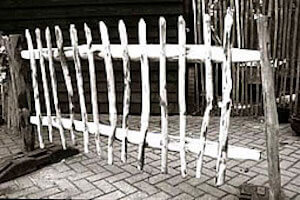
Compas,
 The paling fence is significant as the term 'pale' came to mean the area enclosed by such a fence and later just figuratively 'the area that is enclosed and safe'. So to be 'beyond the pale' was to be outside the area accepted as 'home'.
The paling fence is significant as the term 'pale' came to mean the area enclosed by such a fence and later just figuratively 'the area that is enclosed and safe'. So to be 'beyond the pale' was to be outside the area accepted as 'home'.
Hace unos meses que hablabamos del dicho "beyond the pale."
No me acuerdo como se desarrollaba la conversacion pero yo sugeri' una derivacion y otros sugieron otra.
Aqui hay una explicacion informativa de una pagina web muy util.
Beyond the pale
Meaning
Unacceptable; outside agreed standards of decency.
Origin
Firstly, let's get the spelling clear here. It's 'beyond the pale', and certainly not 'beyond thepail' - the phrase has nothing to do with buckets. The everyday use of the word 'pale' is as an adjective meaning whitish and light in colour (used to that effect by Procol Harum and in countless paint adverts). This 'pale' is the noun meaning 'a stake or pointed piece of wood', a meaning now virtually obsolete except as used in this phrase, but still in use in the associated words 'paling' (as in paling fence) and 'impale' (as in Dracula movies).
 The paling fence is significant as the term 'pale' came to mean the area enclosed by such a fence and later just figuratively 'the area that is enclosed and safe'. So to be 'beyond the pale' was to be outside the area accepted as 'home'.
The paling fence is significant as the term 'pale' came to mean the area enclosed by such a fence and later just figuratively 'the area that is enclosed and safe'. So to be 'beyond the pale' was to be outside the area accepted as 'home'.
Catherine the Great created the Pale of Settlement in Russia in 1791. This was the name given to the western border region of the country, in which Jews were allowed to live. The motivation behind this was to restrict trade between Jews and native Russians. Some Jews were allowed to live, as a concession, 'beyond the pale'.
Pales were enforced in various other European countries for similar political reasons, notably in Ireland (the Pale of Dublin) and France (the Pale of Calais, which was formed as early as 1360).
The phrase itself originated later than that. The first printed reference comes from 1657 in John Harington's lyric poem The History of Polindor and Flostella. In that work, the character Ortheris withdraws with his beloved to a country lodge for 'quiet, calm and ease', but they later venture further:
"Both Dove-like roved forth beyond the pale to planted Myrtle-walk".
Such recklessness rarely meets with a good end in 17th century verse and before long the lovers are attacked by armed men with 'many a dire killing thrust'. The message is clear - 'if there is a pale, decent people stay inside it', which conveys exactly the figurative meaning of the phrase as it is used today.
***
Si no les resulta obvio, fijense que la palabra "pale" tiene la misma raiz etimologica de la palabra "palo" en espanol.
Hasta hace poco, creo que para la gran mayoria de los seres humanos que vivian en el campo, el cerco (o la empalizada=palisade) servia de una separacion muy clara entre "lo domestico" y "la tierra salvaje," una separacion de "lo conocido" de "lo desconocido."
Notense tambien que la palabra cerca/cerco significa "cerca de la casa" mientras "beyond the pale" era el dominio del salvaje, de lo que no tenia nada que ver con "lo domestico" y "lo conocido."
Todo lo que quedaba "beyond the pale=empalizada," o sea mas alla' de la cerca era el dominio del extranjero, del forastero, del salvaje bruto.
Hasta el lunes!
Paz con ustedes,
Alan
No comments:
Post a Comment